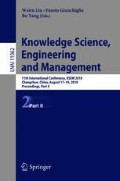Abstract
Word embedding is one common word vector representation with improved performance for sentiment analysis task. Most existing methods of learning context-based word embedding are semantic oriented, but they typically fail to capture the sentiment information. This may result in words with similar vectors but with very different sentiment polarities, thus degrading the followed sentiment analysis performance. In this paper, we propose a novel and efficient method to yield the Sentiment Embedded Semantic Space that captures the connection between the sentiment space and the semantic space. The proposed method is based on K-means and CNN. In addition, we develop a more fine-grained sentiment dictionary based on HowNet Dictionary together with the processing dataset. Extensive experiments on benchmark datasets show that the proposed method leads to more accurate sentiment classifier and reduces the task-specific word embedding effort.
Access this chapter
Tax calculation will be finalised at checkout
Purchases are for personal use only
References
Pang, B., Lee, L.: Opinion mining and sentiment analysis. Found. Trends® Inf. Retrieval 2(1–2), 1–135 (2008)
Sedoc, J., Gallier, J., Foster, D., et al.: Semantic word clusters using signed spectral clustering. In: Proceedings of the 55th Annual Meeting of the Association for Computational Linguistics (ACL) (vol. 1: Long Papers), pp. 939–949 (2017)
Ren, Y., Zhang, Y., Zhang, M., et al.: Improving Twitter sentiment classification using topic-enriched multi-prototype word embeddings. In: AAAI, pp. 3038–3044 (2016)
Tang, D., Wei, F., Qin, B., et al.: Sentiment embeddings with applications to sentiment analysis. IEEE Trans. Knowl. Data Eng. 28(2), 496–509 (2016)
Yu, L.C., Wang, J., Lai, K.R., et al.: Refining word embeddings for sentiment analysis. In: Proceedings of the 2017 Conference on Empirical Methods in Natural Language Processing (EMNLP), pp. 534–539 (2017)
Niu, W., Lei, J., Tong, E., et al.: Context-aware service ranking in wireless sensor networks. J. Netw. Syst. Manag. 22(1), 50–74 (2014)
Wang, X., Li, G., Shi, Z.: Semantic trajectory-based event detection and event pattern mining. Knowl. Inf. Syst. 37(2), 305–329 (2013)
Dai, H., Li, G., Tu, Y.: An empirical study of encoding schemes and search strategies in discovering causal networks. In: Elomaa, T., Mannila, H., Toivonen, H. (eds.) ECML 2002. LNCS (LNAI), vol. 2430, pp. 48–59. Springer, Heidelberg (2002). https://doi.org/10.1007/3-540-36755-1_5
Lan, M., Zhang, Z., Lu, Y., et al.: Three convolutional neural network-based models for learning sentiment word vectors towards sentiment analysis. In: 2016 International Joint Conference on Neural Networks (IJCNN), pp. 3172–3179. IEEE (2016)
Johnson, R., Zhang, T.: Deep pyramid convolutional neural networks for text categorization. In: Proceedings of the 55th Annual Meeting of the Association for Computational Linguistics (ACL) (vol. 1: Long Papers), pp. 562–570 (2017)
Kim, Y.: Convolutional neural networks for sentence classification. arXiv preprint arXiv:1408.5882 (2014)
LeCun, Y., Bottou, L., Bengio, Y., et al.: Gradient-based learning applied to document recognition. Proc. IEEE 86(11), 2278–2324 (1998)
HowNets. http://www.keenage.com
Boureau, Y.L., Ponce, J., LeCun, Y.: A theoretical analysis of feature pooling in visual recognition. In: Proceedings of the 27th International Conference on Machine Learning (ICML 2010), pp. 111–118 (2010)
Hinton, G.E., Srivastava, N., Krizhevsky, A., et al.: Improving neural networks by preventing co-adaptation of feature detectors. arXiv preprint arXiv:1207.0580 (2012)
Mikolov, T., Chen, K., Corrado, G., et al.: Efficient estimation of word representations in vector space. arXiv preprint arXiv:1301.3781 (2013)
Collobert, R., Weston, J.: A unified architecture for natural language processing: deep neural networks with multitask learning. In: Proceedings of the 25th International Conference on Machine Learning, pp. 160–167. ACM (2008)
Mikolov, T., Sutskever, I., Chen, K., et al.: Distributed representations of words and phrases and their compositionality. In: Advances in Neural Information Processing Systems, pp. 3111–3119 (2013)
Kingma, D.P., Ba, J.: Adam: a method for stochastic optimization. arXiv preprint arXiv:1412.6980 (2014)
Pang, B., Lee, L.: Seeing stars: exploiting class relationships for sentiment categorization with respect to rating scales. In: Proceedings of the 43rd Annual Meeting on Association for Computational Linguistics. Association for Computational Linguistics, pp. 115–124 (2005)
Wang, S., Manning, C.D.: Baselines and bigrams: simple, good sentiment and topic classification. In: Proceedings of the 50th Annual Meeting of the Association for Computational Linguistics: Short Papers, vol. 2, pp. 90–94. Association for Computational Linguistics (2012)
Acknowledgment
This work is supported by the National Key Research and Development Program of China (2016YFB0801001, 2016YFB0801004), the International Cooperation Project of Institute of Information Engineering, Chinese Academy of Sciences under Grant No. Y7Z0511101 and Key Lab of Information Network Security, Ministry of Public Security (No. C17614).
Author information
Authors and Affiliations
Corresponding authors
Editor information
Editors and Affiliations
Rights and permissions
Copyright information
© 2018 Springer Nature Switzerland AG
About this paper
Cite this paper
Jiang, J. et al. (2018). Sentiment Embedded Semantic Space for More Accurate Sentiment Analysis. In: Liu, W., Giunchiglia, F., Yang, B. (eds) Knowledge Science, Engineering and Management. KSEM 2018. Lecture Notes in Computer Science(), vol 11062. Springer, Cham. https://doi.org/10.1007/978-3-319-99247-1_19
Download citation
DOI: https://doi.org/10.1007/978-3-319-99247-1_19
Published:
Publisher Name: Springer, Cham
Print ISBN: 978-3-319-99246-4
Online ISBN: 978-3-319-99247-1
eBook Packages: Computer ScienceComputer Science (R0)

